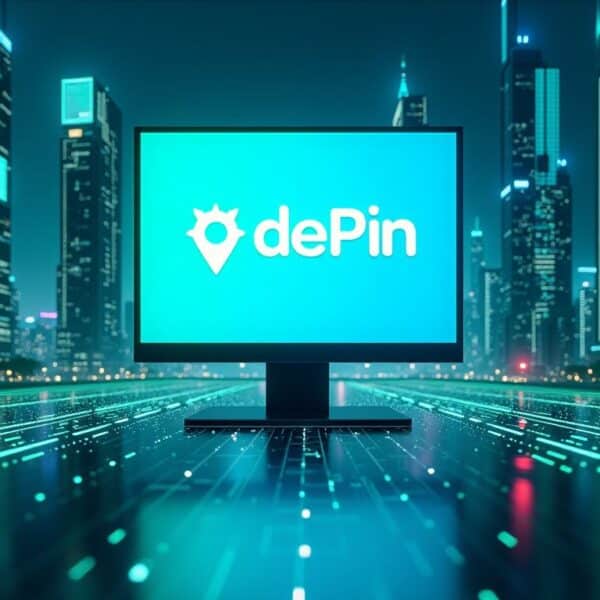The dawn of cryptocurrencies brought with it an evolutionary digital landscape that revolutionized the way we perceive financial transactions. At the core of this transformation is blockchain technology, a robust and innovative framework designed to support these cryptocurrencies. But, what is blockchain, and why does it play such a pivotal role? Essentially, blockchain is a distributed ledger, a decentralized database that is shared across a network of computers, ensuring that no single point of failure can compromise the integrity of data.
Indeed, the value of blockchain lies in its ability to guarantee security and transparency in digital transactions. By allowing data to be stored and verified across its extensive network, blockchain ensures that each digital record or transaction on the ledger is secure from tampering and revision. This introduces a level of reliability and trust that is foundational in the arena of cryptocurrencies. From the pioneering Bitcoin to the swathes of altcoins that have followed, blockchain remains the unshakable backbone that underlies the functionality and credibility of digital currencies.
Key Takeaways
- Blockchain technology is a decentralized system that underpins the operational integrity of cryptocurrencies.
- Understanding what blockchain is, is essential to grasp how it offers security and transparency in the digital economy.
- The decentralized nature of blockchain is crucial in managing digital transactions without the need for a central authority.
- Cryptocurrencies like Bitcoin rely on blockchain to authenticate and record transactions on a public ledger.
- The future potential of blockchain extends beyond cryptocurrencies, impacting other sectors with its immutable and transparent record-keeping capabilities.
Demystifying Blockchain: An Introduction
As the digital landscape continues to evolve, the significance of blockchain technology becomes increasingly apparent. Originally conceived as the foundation for cryptocurrencies, blockchain has emerged as a revolutionary digital ledger technology, offering unmatched security and transparency across various sectors.
What Is Blockchain and Why Does It Matter?
At its core, blockchain technology explained simply is a decentralized digital ledger that records transactions across multiple computers. This setup ensures that no single point of failure can alter the information, which safeguards integrity and builds trust among users. The significance of blockchain is rooted in its ability to offer transparency while securing data, a fundamental aspect that has been transformative not just in finance but in supply chain management, healthcare, and even voting systems.
The Discussion of the evolution of blockchain technology from its inception, highlighting significant milestones and how it has transitioned into a cornerstone of digital currency and beyond.
The inception of blockchain dates back to 2008, primarily designed to serve as the public transaction ledger for Bitcoin. However, its potential quickly transcended this role, marking pivotal milestones in its evolution. From enabling smart contracts with Ethereum to enhancing privacy through Zcash, blockchain has broadened its applicability, underscoring its blockchain significance beyond mere currency transactions.
The table below illustrates key milestones in the evolution of blockchain technology:
| Year | Milestone | Impact |
|---|---|---|
| 2009 | Launch of Bitcoin | Introductory phase of blockchain as a financial tool. |
| 2013 | Introduction of Smart Contracts | Expansion of blockchain into legal and contract management. |
| 2015 | Development of Ethereum | Enhanced capabilities for developing decentralized applications. |
| 2017 | Initial Coin Offerings (ICOs) Peak | Significant funding method for blockchain startups, widening the technology’s adoption. |
| 2020 | Integration in Supply Chains | Blockchain’s application in tracking and verifying supply chains for better transparency. |
Each progression stage reflects not only technological advancements but also a growing recognition of blockchain’s role in securing and streamlining digital interactions in a globally connected age. As we continue to unpack and understand this technology, its pervasive impact across industries becomes more evident, proving that the potential of blockchain extends far beyond its initial financial applications.
The Architecture of Blockchain Explained
Understanding how blockchain works is essential to appreciating its revolutionary impact across industries. At its core, the blockchain structure consists of a series of interconnected blocks that are decentralized and jointly manage a continuous, public ledger of records known as the distributed ledger.
Each block within the blockchain is secured and bound to each other using cryptographic principles, ensuring not just security but transparency in transactions. By understanding the internals of a blockchain, we can uncover the gears and cogs that make digital currencies like Bitcoin so resilient and trustworthy.
A critical component of blockchain architecture is its nodes. These nodes are individual computers that validate each transaction before it is verified and added to the block. Here, miners come into play, applying computational power to solve complex mathematical problems that confirm transactions and link new blocks to the chain.
| Component | Function | Role in blockchain structure |
|---|---|---|
| Node | Validate transactions | Maintains the integrity and consensus of the distributed ledger |
| Block | Store transaction data | Keeps data secure and immutable |
| Miner | Confirm transactions and create new blocks | Essential for the extension and validation of the blockchain |
Each block contains a cryptographic hash of the previous block, a timestamp, and transaction data, commonly represented as a Merkle tree. This design ensures that once data has been recorded in a block, altering it retroactively becomes computationally impractical, if not impossible, thus promoting a high degree of security and trust.
This robust blockchain structure supports the how blockchain works philosophy that underpins its operations, making it not just a technology of today but also of the future. Through this lens, it is clear why industries beyond finance, such as healthcare and supply chain management, are eager to adopt blockchain solutions to enhance efficiency and transparency.
Decentralization: Trust and Transparency in Action
The concept of decentralization has been revolutionary in the world of technology, particularly through its implementation in blockchain platforms. Unlike traditional centralized systems where a single entity has control, decentralized systems distribute the authority and trust across multiple nodes. This structure not only enhances trustless systems but also ensures transparent transactions by allowing open participation and visibility to all involved parties.
One of the primary advantages of a decentralized blockchain is that it eliminates the need for intermediaries, thereby fostering a trustless system. Parties involved in transactions are no longer required to establish trust based on personal assurance or reputation; instead, trust is built into the system through complex cryptographic algorithms, ensuring that all transparent transactions are verifiable and irreversible.
| Feature | Traditional System | Decentralized System |
|---|---|---|
| Control | Centralized authority | Distributed control |
| Trust Requirement | High (intermediaries needed) | Low (built into the system) |
| Transparency | Limited (behind closed doors) | High (open ledger) |
| Efficiency | Varies (often lower due to bottlenecks) | High (no intermediaries) |
| Security | Vulnerable to central point of failure | Enhanced by distributed consensus |
This table showcases how the shift from traditional to decentralized systems could potentially transform various industries by providing a more reliable, transparent, and efficient framework for conducting operations.
To conclude, the shift towards decentralization within blockchain technology does not just support transparent transactions but fundamentally changes the way entities interact and trust one another. Through such a trustless system, blockchain’s potential goes beyond mere financial transactions, paving the way for an era where decentralization is synonymous with security and transparency.
How Blockchain Powers Cryptocurrencies
The revolutionary concept of blockchain and cryptocurrencies began with the Bitcoin blockchain, which set the standard for how digital currencies could be secured and decentralized. This section delves into the intricacies of how blockchain acts as the backbone for Bitcoin and explores the diverse range of altcoins that have since emerged, each modifying the original formula to better suit specific needs.
The Relationship Between Blockchain and Bitcoin
Blockchain technology is fundamentally entwined with Bitcoin, the first digital currency to successfully use this technology to achieve decentralization and security. The Bitcoin blockchain is a public ledger that records all transactions in a secure, transparent, and immutable way. This ensures that users can trust the system without the need for a central authority.
Altcoins and Their Unique Blockchains
Following the success of Bitcoin, numerous altcoins have been created, each with its own unique blockchain adaptations. These altcoins use the core principles of blockchain technology but often differ in terms of consensus mechanisms or the addition of new features such as smart contracts or increased transaction privacy.
| Feature | Bitcoin | Altcoins |
|---|---|---|
| Consensus Protocol | Proof of Work | Various (e.g., Proof of Stake, Delegated Proof of Stake) |
| Transaction Speed | 10 minutes per block | Ranges from seconds to minutes |
| Privacy Features | Basic privacy | Enhanced (e.g., Zcash with zk-SNARKs) |
| Smart Contracts | No native support | Supported by many (e.g., Ethereum) |
As the table illustrates, while all these cryptocurrencies operate on the fundamental premise of decentralized digital currency, differences in features like privacy, smart contracts, and transaction speeds highlight the customization and versatility that blockchain technology offers to meet various digital currency needs.
Blockchain Technology: Key Features and Mechanisms
Blockchain technology is renowned for its robust blockchain features which contribute significantly to its efficacy and reliability. These features, including immutability, decentralization, and advanced consensus protocols, are fundamental to the benefits of blockchain such as enhanced security and trust among parties.
One of the most praised features of blockchain is its immutability. This ensures that once data has been recorded on a blockchain, it cannot be altered without the consensus of the network, which would require enormous computing power. This makes blockchain an extremely secure technology, resistant to fraud and unauthorized alteration.
Moreover, blockchain operates on a decentralized network that mitigates risks associated with centralized data storage. Without a central point of failure, blockchain enhances data security and availability, reducing potential downtimes and attacks significantly.
At the heart of blockchain’s functionality are its consensus protocols, which are crucial for maintaining the network’s integrity and agreement on data validity. These protocols include systems like Proof of Work (PoW) and Proof of Stake (PoS), each having its own mechanism to validate transactions and add new blocks to the chain.
Below is a comparative overview of how different consensus protocols play a pivotal role in the functionality of blockchains:
| Protocol | Method | Usage |
|---|---|---|
| Proof of Work (PoW) | Miners solve complex mathematical problems to validate transactions. | Used in Bitcoin, Litecoin. |
| Proof of Stake (PoS) | Validators are chosen to create new blocks based on the number of coins they hold and are willing to “stake” as security. | Used in Ethereum 2.0, Cardano. |
| Delegated Proof of Stake (DPoS) | Stakeholders vote for a small number of delegates who manage the blockchain on behalf of others. | Used in EOS, TRON. |
These consensus protocols not only help in securing the network but also ensure that all participants are in agreement about the current state of the ledger, which is crucial for the system’s overall transparency and trust.
The benefits of blockchain like these are what make it a groundbreaking technology with the potential to revolutionize various industries by providing a new layer of functionality and security unseen in current systems.
Consensus Mechanisms: Proof of Work vs. Proof of Stake
The integrity and efficiency of blockchain networks largely hinge on their chosen consensus mechanisms, essential protocols that allow transactions to be universally agreed upon in a decentralized environment without a central authority. The most prominent mechanisms are Proof of Work (PoW) and Proof of Stake (PoS), each having significant impacts on blockchain security and operational dynamics.
Understanding Proof of Work (PoW)
Originally implemented by Bitcoin, the Proof of Work method involves solving complex mathematical puzzles to validate transactions and create new blocks. This process, known as mining, requires substantial computational power and, by extension, consumes a considerable amount of energy. The security of PoW lies in its requirement for a significant amount of work from the miners, thus making any network attacks economically unfeasible.
Exploring Proof of Stake (PoS) and Its Variants
As an alternative, Proof of Stake offers a less energy-intensive process by allowing block validation to be based on the stake or ownership a validator has in the network. Validators are chosen to create new blocks based on factors such as the amount of currency they hold and the length of time they have held it. PoS not only reduces energy consumption but also enhances security by aligning the validators’ incentives with the network’s long-term success.
The differences between these two consensus mechanisms dramatically affect their respective blockchain’s energy consumption, security measures, and even governance models. While PoW is celebrated for its robustness against attacks, PoS is acclaimed for its scalability and energy efficiency, addressing one of the blockchain technology’s most pressing concerns.
Deciding between Proof of Work and Proof of Stake involves considering several factors including the desired level of decentralization, trust model, and environmental impact. As blockchain technology evolves, the developments in consensus mechanisms will continue to provoke debate about the best strategies for securing and optimizing blockchain networks.
Smart Contracts: Automating Agreements on the Blockchain
The evolution of blockchain programming has ushered in an era of automated agreements, predominantly through smart contracts. These digital contracts execute themselves automatically under predefined conditions, eliminating the need for intermediaries and reducing the potential for disputes. The reliability and efficiency of smart contracts stem from their integration with blockchain technology, enabling automatic enforcement and execution that is tamper-proof and transparent.

Smart contracts are written using specialized blockchain programming languages such as Solidity, and are deployed on blockchain platforms like Ethereum, which supports Turing-complete scripts. The essence of a smart contract is that once the predetermined rules are met, the contract automatically enforces the agreement.
- Efficiency in transaction processing and reduced administrative overhead.
- Enhanced security through decentralized execution, limiting fraud and interference.
- Transparent transactions that are recorded on a public ledger, accessible by all parties involved.
The application of smart contracts spans various industries, from real estate transferring ownership, to healthcare managing patient data, and even in the supply chain, ensuring the authenticity of goods and automatic payments upon delivery. This diverse applicability showcases the potential of smart contracts to revolutionize traditional business models by embedding automated agreements into the fabric of economic transactions.
While the adoption of smart contracts is promising, it’s crucial for developers and businesses to understand the intricacies of blockchain programming to fully leverage this technology. With ongoing advancements and an increasing number of platforms supporting smart contracts, the scope of automated agreements will undoubtedly expand, making business operations more efficient and trustworthy.
The Role of Cryptography in Securing Blockchain Networks
Cryptography plays a pivotal role in the robust architecture of blockchain technology, fortifying the security that is essential for maintaining a trustworthy system. By integrating complex cryptographic methods, blockchain efficiently protects data integrity and ensures secure transactions across its distributed network.
Hash Functions and Data Integrity
Hash functions are a fundamental aspect of blockchain security. These cryptographic functions take input data and produce a fixed-size string of bytes, typically a hash value that is unique to each set of data. Any alteration to the original data, even a minor change, results in a completely different hash, which is critical for ensuring the data integrity in blockchain transactions.
| Hash Function | Description | Use Case in Blockchain |
|---|---|---|
| SHA-256 | Produces a 256-bit hash value, widely recognized for its high security and speed. | Used by Bitcoin for mining and creating transaction block hashes. |
| MD5 | Earlier used hash function, produces a 128-bit hash. Faster but less secure compared to SHA-256. | Less commonly used in new blockchain systems due to vulnerability to hash collisions. |
| RIPEMD-160 | A 160-bit cryptographic hash, often used alongside SHA-256 to add an extra layer of security. | Utilized in Bitcoin’s multi-signature wallet addresses. |
Public and Private Keys: The Fundamentals of Crypto-Security
Public and private keys form the cornerstone of cryptography in blockchain technology. These keys help in achieving secure peer-to-peer communications and ensure safe access to blockchain assets. A private key is a secret key that is used to sign transactions providing ownership of the tokens, while the public key is shared in the network and used to verify the transactions assured by the private key.
Blockchain security is not just about protecting transactions but also about upholding privacy and ensuring that each transaction is authenticated and verifiable. Public and private keys enable this level of security, making unauthorized access extremely difficult without compromising the efficiency of transactions.
Blockchain Technology Beyond Cryptocurrency
While widely recognized for its role in powering cryptocurrencies, blockchain technology’s utility extends far into various sectors, revolutionizing how operations and transactions are processed beyond digital currencies. This section delves into two significant applications: enhancing supply chain transparency and the tokenization of assets.
Blockchain in Supply Chain Management
Blockchain applications in supply chain management offer unparalleled transparency, traceability, and efficiency. By integrating blockchain into the supply chain, companies can track the journey of products from manufacturer to end consumer with immutable record-keeping. This capability not only aids in verifying authenticity and preventing fraud but also enhances operational efficiency by providing real-time insights into logistics processes. Leading brands in various industries have started to adopt blockchain to secure their supply chains, ensuring product integrity and consumer trust.
Tokenization of Assets and Smart Property
Tokenization, a method made viable by blockchain, involves converting rights to an asset into a digital token on a blockchain network. This approach can be applied to both tangible assets like real estate and intangible assets such as intellectual property. Smart property is an innovative application of this concept, where ownership can be controlled via blockchain, making transactions transparent, secure, and immediate. Tokenization not only simplifies the process of buying and selling assets but also offers a revolutionary approach to managing ownership records and conducting audits.
- Increased security and reduced risk of fraud
- Simplified asset exchange processes
- Enhanced transparency in asset management
Challenges and Limitations of Blockchain Adoption
While blockchain technology promises revolutionary changes across various sectors, its adoption is not without significant hurdles. From technical issues to complex regulatory landscapes, understanding these challenges is crucial for any stakeholder in the blockchain ecosystem.
Scalability Issues and Network Congestion
One of the most pressing blockchain challenges is scalability. As blockchain networks like Bitcoin and Ethereum have grown in popularity, they face performance bottlenecks due to limited processing capacity, leading to network congestion and higher transaction fees. This scalability issue restricts the potential for blockchain to support high-volume applications crucial for mainstream financial systems and enterprise solutions.
Legal and Regulatory Hurdles
The adoption of blockchain is further complicated by legal issues and regulation. Each country’s approach to blockchain and cryptocurrencies varies significantly, creating a fragmented landscape of legal frameworks. For instance, while some countries embrace blockchain innovations and create friendly regulations, others impose strict restrictions or outright bans that complicate the deployment and adoption of blockchain technologies.
These challenges highlight the need for ongoing dialogue among technologists, business leaders, and policymakers to ensure that blockchain technology can evolve in a way that maximizes its benefits while minimizing potential disruptions and legal conflicts.
Future Trends in Blockchain Technology
The landscape of blockchain trends is continually evolving, promising revolutionary changes across various industries. As we delve into the future of blockchain, a few predictions stand out, fueled by ongoing innovation in blockchain technologies. These innovations are not just enhancing current applications but are paving the way for integration with emerging tech like quantum computing and AI.
One significant trend gaining traction is the sustainability of blockchain operations, reflecting a shift towards greener, more energy-efficient practices. This shift is crucial as environmental concerns become ever more pressing. Another area of intense focus is the enhancement of security protocols to prevent breaches that could undermine public trust in blockchain systems.
- Increasing adaptation of blockchain in mainstream finance.
- Expanding the use of blockchain for secure medical records.
- Advances in cryptographic techniques to bolster blockchain security.
- Greater interconnectivity between blockchain and IoT devices.
As these blockchain trends materialize, the innovation in blockchain is likely to accelerate, offering groundbreaking solutions across sectors and establishing new standards for data integrity, transparency, and accessibility. These advancements suggest a bright future for blockchain, ensuring its position at the forefront of digital transformation strategies.
The Impact of Blockchain on Global Financial Systems
The advent of blockchain technology is poised to revolutionize traditional financial systems by introducing more decentralized frameworks that shift control and power from central authorities to individual users. The blockchain financial impact and banking disruption caused by such technological shifts are reshaping how money flows and how financial operations are managed globally.
Disruption in Banking and Remittances
Blockchain technology is particularly influential in the banking sector, restructuring foundational aspects of financial services including transactions, remittances, and security frameworks. Banking disruption through blockchain introduces enhanced levels of transparency and efficiency, reducing or entirely eliminating the need for traditional intermediaries such as banks and money transfer services.
The Emergence of Decentralized Finance (DeFi)
Simultaneously, the rise of Decentralized Finance (DeFi) marks a significant stride towards achieving financial inclusion and democratization. By leveraging decentralized networks, DeFi platforms allow users to engage in financial activities including lending, borrowing, and trading without the oversight of central financial institutions. This aspect of DeFi eliminates biases and barriers often presented by traditional financial systems, advocating for a universally accessible financial landscape.
| Feature | Traditional Banking | DeFi (Decentralized Finance) |
|---|---|---|
| Control | Centralized institutions (Banks) | Smart contracts and distributed systems |
| Accessibility | Limited by geography and bureaucracy | Open to anyone with internet access |
| Transparency | Often opaque | Fully transparent and verifiable |
| Fees | High transaction and service fees | Minimized or no fees |
| Innovation Pace | Slower due to regulatory and operational inertia | Rapid innovation driven by technology |
Benefits of Blockchain: Security, Efficiency, and More
The integration of blockchain technology into various sectors has revolutionized the way transactions are handled, primarily due to its blockchain advantages such as secure digital ledger functionalities and efficient transaction processing. This foundation has not only enhanced security but also streamlined operations, reducing time and costs associated with traditional systems.
One of the key blockchain advantages is the establishment of a secure digital ledger, which acts as an immutable record of transactions. This security feature is crucial in industries like finance and healthcare where the integrity of data is paramount. Moreover, the efficient transaction processing capabilities of blockchain have made it a favorite among businesses looking to optimize operational efficiencies.
Below, we explore real-world applications and benefits brought by these features:
- Financial Sector: Faster cross-border transactions with reduced costs.
- Healthcare: Enhanced security in patient data management, ensuring confidentiality and integrity.
- Supply Chain Management: Improved traceability and transparency from manufacturer to end consumer.
| Industry | Key Benefit | Result |
|---|---|---|
| Banking | Reduced transfer times | 24/7 global transactions |
| Retail | Fraud reduction | Increased consumer trust |
| Real Estate | Streamlined property transactions | Decreased legal complexities |
As evidenced, the secure digital ledger and efficient transaction processing offered by blockchain provide robust solutions that address traditional inefficiencies and vulnerabilities. The blockchain advantages are clear and vast, offering transformative possibilities across numerous industries. As adoption continues, we can only expect these benefits to expand further, solidifying blockchain’s role in modern digital transactions.
Conclusion
As we stand on the cusp of a new era, the blockchain future beckons with promises of innovation and transformation. Throughout this comprehensive journey, the multi-faceted layers of blockchain technology have been unveiled, from its secure ledger capabilities to the revolutionary potential it holds across various sectors. Embracing blockchain technology is not just about appreciating its current applications but also about anticipating the ways it will continue to evolve and shape our digital landscape. Its impact reaches far beyond the financial domain, carving paths for advancements in supply chain management, asset tokenization, and ensuring data integrity.
The encouragement to delve deeper into this technology comes with an understanding of its capacity to redefine concepts of transparency, efficiency, and security. Industries around the globe are progressively recognizing the benefits of integrating blockchain into their operations, which could signal a paradigm shift in how business and governance are conducted. The revolutionary potential of blockchain is palpable, fueling innovations such as decentralized finance and smart contracts, forging systems that are not only resilient but also equitable.
As we move forward, it is essential to stay informed and agile in a world where blockchain’s relevance only continues to grow. The path ahead is one of continuous discovery, opportunities, and challenges. Individuals and organizations alike are invited to anticipate the waves of change wrought by this formidable technology, preparing to adapt and thrive in an increasingly blockchain-integrated society. It is not just about keeping pace with technology but also about actively participating in the shaping of a blockchain-empowered future.
FAQ
What is blockchain and how does it relate to cryptocurrencies?
Blockchain is a distributed ledger technology that ensures secure and transparent digital transactions. It’s the backbone of most cryptocurrencies, including Bitcoin, serving as a decentralized database that records all transactions across a network.
How does blockchain technology work?
Blockchain works by recording transactions in ‘blocks,’ which are linked together in a ‘chain.’ Each block contains a cryptographic hash of the previous block, a timestamp, and transaction data. Once a block is added to the blockchain, the information is immutable and transparent to all participants on the network.
What are the benefits of using blockchain?
The benefits of blockchain include enhanced security due to its decentralized and immutable nature, increased transparency since all transactions are visible to participants, and reduced fraud. It also allows for more efficient transaction processing compared with traditional banking systems.
What’s the difference between Bitcoin’s blockchain and other blockchains?
Bitcoin’s blockchain is a public ledger that records Bitcoin transactions. Other blockchains, such as those for altcoins, may have different features, consensus mechanisms, or design principles designed for various use-cases beyond just currency.
Can you explain the concept of decentralization in blockchain?
Decentralization in blockchain refers to the spread of network activities across a wide array of computers, or nodes, rather than relying on a central authority. This helps to create a trustless system where transactions can occur directly between users securely and transparently.
What is a smart contract?
A smart contract is a self-executing contract with the terms of the agreement directly written into code. It automates and enforces contract execution, allowing trusted transactions without intermediaries when certain conditions are met on the blockchain.
How do consensus mechanisms like Proof of Work and Proof of Stake contribute to blockchain security?
Consensus mechanisms are protocols that ensure all transactions are verified and agreed upon by network participants. Proof of Work requires computationally intensive tasks to validate transactions, whereas Proof of Stake allows validators to confirm transactions based on the number of coins they hold and are willing to “stake” for the right to validate.
What role does cryptography play in blockchain security?
Cryptography secures transactions and controls the creation of new units in a blockchain. Crucial elements include hash functions, which help maintain data integrity, and public-private key pairs, which ensure secure communications and control access to blockchain assets.
How is blockchain being used beyond cryptocurrencies?
Beyond cryptocurrencies, blockchain applications include supply chain management, where it ensures transparency and traceability, and asset tokenization, which involves creating digital representations of tangible and intangible assets on the blockchain.
What are the challenges of blockchain adoption?
Some challenges of blockchain adoption include scalability issues that affect transaction speeds and network congestion. Additionally, there are various legal and regulatory hurdles because the technology is still relatively new and rapidly evolving.
What are the emerging trends in blockchain?
Emerging trends in blockchain include the integration of artificial intelligence (AI), the development of central bank digital currencies (CBDCs), increased use of blockchain in identity verification processes, and the growth of decentralized finance (DeFi).
How is blockchain disrupting global financial systems?
Blockchain is disrupting global financial systems by enabling peer-to-peer transactions without the need for intermediaries, lowering transaction costs, and providing financial services to the unbanked population through decentralized finance (DeFi) platforms.

















































